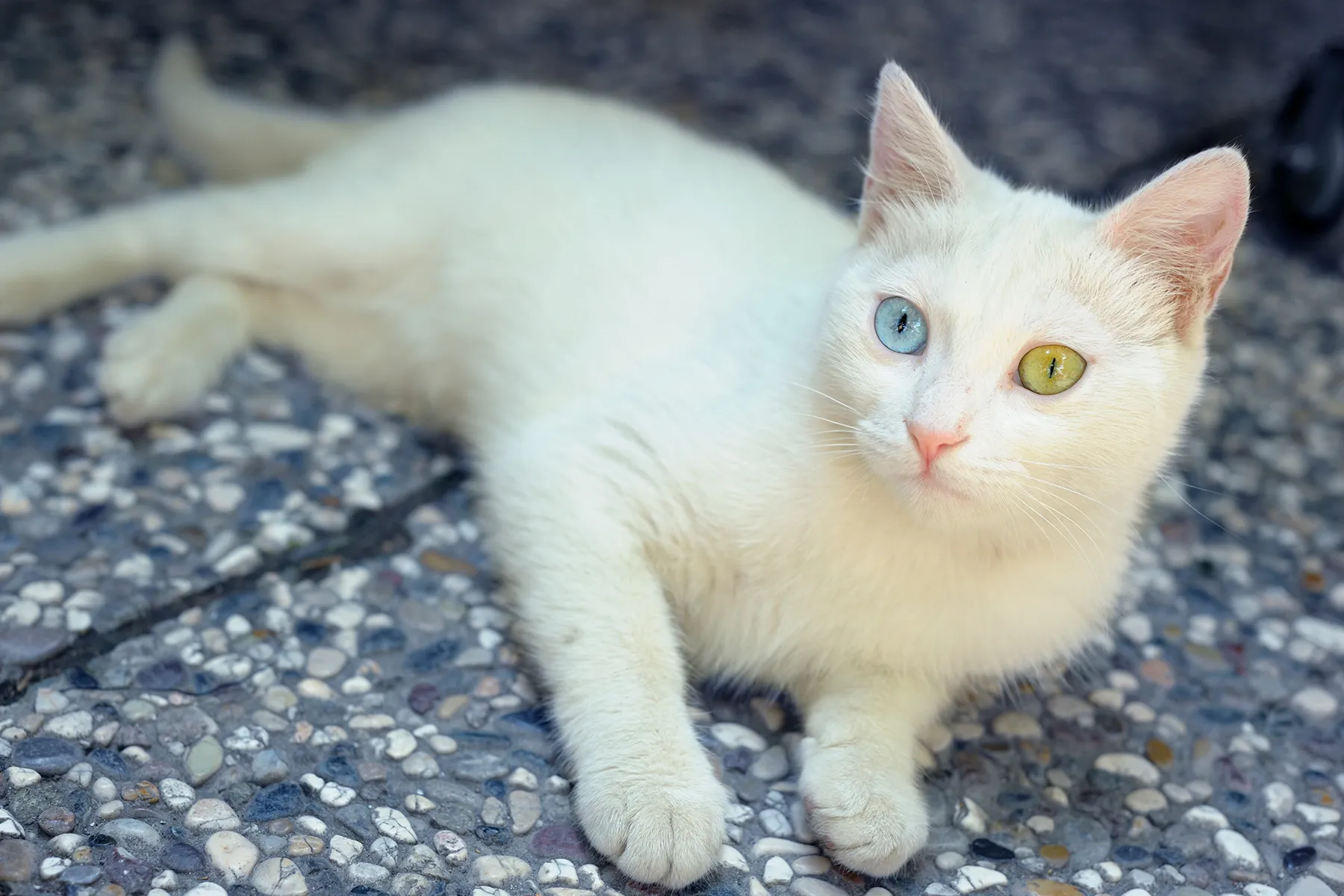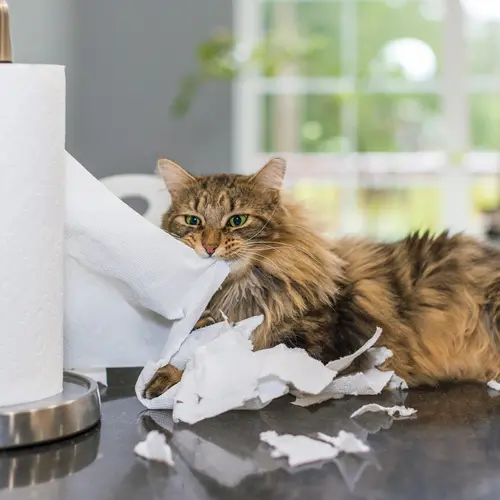
Turkish Van cats are a unique, playful breed originating in a remote part of Turkey. They’re sometimes called “the swimming cat” because of how much they enjoy water.
These cats are delightful, energetic companions that are a welcome addition to many homes. Unfortunately, they’re a scarce breed. If you’re looking to adopt, finding a kitten could take a long time.
Characteristics of a Turkish Van Cat
Body size. The Turkish Van cat size is medium to large compared to other breeds. These cats are slow to mature. They take anywhere from three to five years to reach full size. Males are larger than females.
Healthy males can weigh anywhere from 10 to 20 pounds. Healthy females weigh anywhere from seven to 12 pounds. Make sure to talk to your veterinarian if you’re concerned that your cat is too far underweight or overweight.
Body shape. Turkish Van cats have sturdy torsos with full chests. They should have moderate boning and a good amount of muscle.
Their strong legs end in neat, round feet. The tails are moderate in length and have a minimum of two inches long fur. The result is a plumed or bottlebrush type of tail.
These cats can have relatively large heads. The males tend to have broader heads than the females. They’re wedge-shaped and topped by large ears. The ears should be reasonably far apart and high up on the skull. Feathering on their insides is considered preferable by the breed standard.
Lifespan. The Turkish Van cat lifespan is normal for many cat breeds. They live an average of 12 to 17 years. This means you should be prepared for a long life with your pet before adopting one.
Coat. Turkish Van cats have distinct, attractive coats. They’re mostly white and only have coloration on their heads and tails. Some are entirely white. The coloration in their patches can vary widely. Almost all color combinations are acceptable within the breed. Examples include:
- Red
- Brown
- Blue
- Cream
- Black
The coats are semi-long and, for the most part, don’t involve an undercoat. Their textures are as unique as their coloration. The cats almost feel like cashmere to the touch. This thick layer works to essentially waterproof the cats.
Eyes. Turkish Van cats have eyes that can come in a variety of shapes. The shapes can range from walnut to peach pit. They’re set at a slight slant within the skull. The eyes can have one of three color patterns:
- All blue
- All amber
- Odd eyes — this means that one eye is blue and the other is amber
Many owners highly value the odd-eyed cats.
Personality. The Turkish Van cat's character is very loving and loyal. They like attention and cuddling, but you should let them come to you. Leave space for them nearby when you sit down, and they’re sure to jump up and ask for your attention.
They love to play with their owners and are curious enough to investigate your activities as you go about your life. Overall, these cats are very sweet, but they can also be mischievous. Be prepared for some loving energy if you adopt a member of this breed.
Caring for a Turkish Van Cat
Grooming. Turkish Van cats are relatively simple to groom. Brush them every so often to remove extra dead hairs and keep their coats looking shiny. Because of their fondness for water, they occasionally enjoy a nice bath but don’t need them to stay clean.
To complete your cat's grooming routine you should:
- brush their teeth daily
- regularly check their ears for signs of dirt
- trim their nails once or twice a month
Feeding. Consult your veterinarian for the most accurate feeding advice for your cat. Some details that you should keep in mind include your cat's:
- Age
- Energy level
- Breed
These are all factors that affect how much food your cat needs. Your cat will also have different nutrient requirements based on other lifestyle factors. You should find a brand that's best for your particular cat.
Ensure your pet has access to clean, fresh water at all times. Cats can have problems with dehydration. Try these tips to get your cat to drink more water:
- Use a flowing water fountain.
- Keep your pet's bowl filled to the brim — cats don't always like it when their whiskers have to touch the edge.
- Put water in multiple locations to give your cat plenty of options.
Exercise and mental stimulation. Turkish Van cats are an active cat breed. They love playing games and chasing after toys. These enthusiastic cats have even been known to turn somersaults and jump up to catch toys in midair.
They’re also very intelligent. So, without proper outlets, this energy can turn into mischievous and disruptive behavior. Leave out plenty of toys so they can entertain themselves.
Veterinary visits, medications, and immunizations. When you adopt a pet, you should take the time to find a veterinarian you trust with your pet's health and safety. They'll help monitor your pet throughout their lifetime and ensure they get all the correct vaccinations and medications when needed.
One of the first things to check is whether or not your cat has a complete set of vaccinations. This includes vaccinations for:
- Feline distemper
- Feline herpes virus
- Calicivirus
- Rabies
Other vaccinations exist, but not every cat needs them. These are called non-core vaccinations. They can help prevent problems like feline leukemia.
Unlike dogs, there's no treatment for heartworm in cats. Instead, it would be best if you tried to prevent this problem in your pet. Have your cat take a year-round preventative that your veterinarian recommends.
Your cat could develop a flea infestation at any time, but they tend to be more common during the summer months. Year-round flea and tick control is recommended.
Health Problems To Watch For with a Turkish Van Cat
In general, Turkish Van cats are a very healthy breed. There aren’t any health problems that are unique to these cats. But your pet could still have several common cat conditions.
Some Turkish Van cat health problems to be aware of include:
- Respiratory issues. Symptoms of these conditions are a bit like a cold in humans. They include coughing, sneezing, congestion, and fevers. Some conditions, like pneumonia, are more serious than others. Bring your cat to the veterinarian as soon as you notice symptoms so you can begin treatment as soon as possible. Many conditions will clear up on their own in a few weeks, but your veterinarian may prescribe medications to help with symptoms or administer fluid if your cat is dehydrated.
- Cancer. There are a handful of cancers that are relatively common in felines. There are few early signs, but keep an eye out for any lumps, weight loss, and behavioral changes. Depending on the stage, treatment could involve surgery, chemotherapy, or radiation.
- Diabetes. Some cats can have problems regulating their blood sugar. Look for signs of high blood sugar in your pet, including increased urination, lethargy, shortness of breath, weight loss, and increased thirst. Your veterinarian can check for signs of diabetes using blood tests. Treatment typically involves medications and dietary changes.
Make sure that your cat sees a veterinarian at least once a year. This will help you catch conditions early and ensure that your cat lives its healthiest, happiest life.
Special Considerations for a Turkish Van Cat
There are a few things that you should keep in mind before you make a Turkish Van cat a member of your family. One of their most unique attributes is how much they like water. They enjoy swimming around and will likely love it if you give them a chance to get wet.
You’ll find them playing with water from your faucets, in their bowls, and wherever you leave it. Some may even learn to turn on faucets by themselves. You’ll need to limit their access or be prepared to clean up their messes.
These cats are good with pets, including other cats and dogs. They just need to make sure that they’re the ones in charge.
Turkish Van cats can do well with strangers but generally aren’t good with young children. This is because they don’t like being picked up or held for long periods. Make sure that children are old enough to understand your cat’s boundaries before introducing them. Otherwise, someone could end up getting scratched.
History of Turkish Van Cats
Turkish Van cats are an ancient, natural breed that evolved in relative seclusion in the mountainous areas of modern-day Turkey. The breed shouldn’t be confused with another famous Turkish breed: the Turkish Angora. These breeds evolved in different regions of the country and have distinct characteristics.
These cats have been recognized as distinct creatures since the Middle Ages, but they didn’t reach the Western world until the mid-1950s. Two women — Laura Lushington and Sonia Halliday — were exploring the country when they stumbled upon members of this unique breed.
They acquired two kittens and continued to travel with them around the country. When they realized that their new kittens actually liked to swim, they decided to promote them as a new breed.
They brought the cats back to England and began a small breeding program. The U.K.-based group called the Governing Council of the Cat Fancy (GCCF) was the first to recognize the breed in 1969. Turkish Van cats didn’t make it to the U.S. until 1982.
These cats remain relatively rare worldwide, even within their home country. You may have to search far and wide before finding one for sale. You may even have to travel to Turkey.


